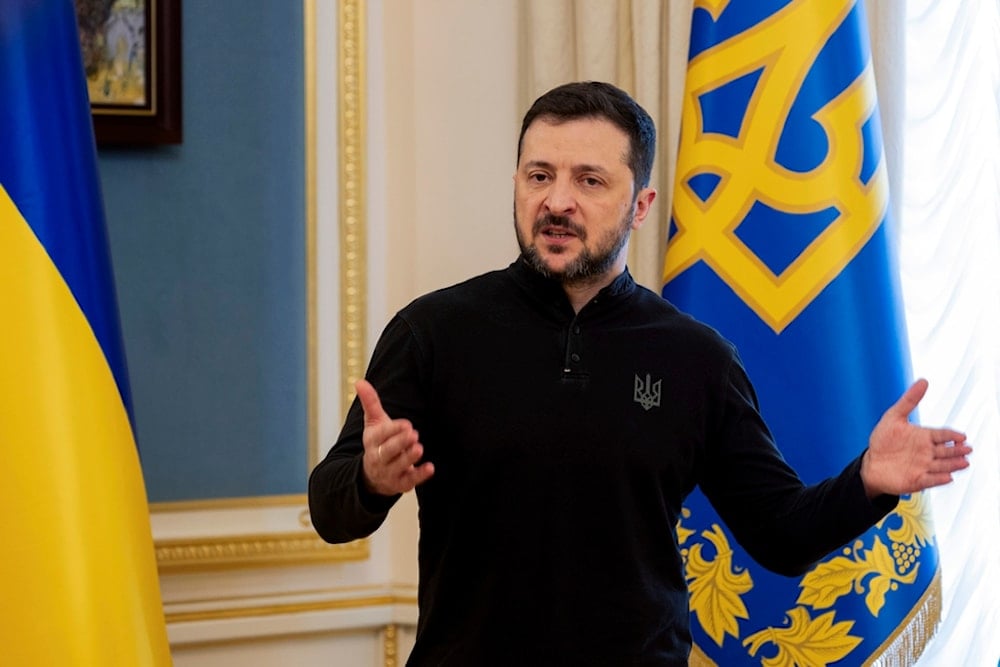Trump wants to get rid of Zelensky, The Economist says
A report by The Economist highlights former US President Donald Trump's apparent desire to sideline Ukrainian President Volodymyr Zelensky, as Kiev faces growing isolation amid US-Russia talks.
-

Ukraine's President Volodymyr Zelensky gives a press conference in Kiev, on Wednesday, Feb. 19, 2025 (AP)
US President Donald Trump is looking to "get rid of" Ukrainian President Volodymyr Zelensky amid growing tensions between the two leaders, The Economist has reported. This comes as Trump signals a shift in US policy on Ukraine, particularly after recent US-Russian talks in Riyadh that excluded Kiev.
Trump’s decision to engage with Russian President Vladimir Putin and his apparent willingness to "rehabilitate the Kremlin" have caused shockwaves within Ukraine’s political circles, The Economist said noting, "By now, few are truly surprised."
A senior Ukrainian lawmaker from Zelensky’s party admitted, "Our mental state was not good the day we heard the news, but we were expecting it."
Opposition members in Ukraine’s parliament describe a sense of "foreboding" as they prepare for the possibility of having to vote on a humiliating ceasefire deal.
The exclusion of Ukrainian representatives from key negotiations, coupled with the growing perception that Washington is turning away from Kiev, has deepened fears among Ukrainian officials.
According to The Economist, many Ukrainian elites believe that Trump’s rhetoric echoes a potential Russian trap—one that involves calling for a ceasefire without security guarantees and pushing for immediate elections that could fracture Ukraine’s unity.
Trump wants to 'get rid of Zelensky'
A former diplomat quoted by the magazine stated that Trump "appears to want to get rid of Zelensky," adding, "This is not about elections, it’s about getting rid of Zelensky."
Many Ukrainians are losing faith in their leader; a recent poll revealed that while Zelensky remains the country’s most popular politician, he would lose a future election by 30% to 65% to his former top general, Valery Zaluzhny. Public trust in Zelensky has also fallen to 52%, a sharp drop from the 90% approval he had at the war’s outset.
Despite these challenges, there is still no formal deal in place. However, many developments align with Ukraine’s worst-case scenario. Trump has multiple levers he could use to pressure Ukraine into accepting a deal.
As The Economist highlights, he "can—and very likely will—cut or stop military aid." He could also unilaterally lift sanctions on Russia or withdraw critical support such as Starlink, which is vital for Ukraine’s battlefield communications.
If implemented, the worst-case scenario for Ukraine would involve "a ceasefire without effective security guarantees; elections that result in political paralysis, a weak presidency, a fractious parliament; then demobilization, mass emigration, and the beginning of internal disintegration," the magazine warns.
'Zelensky a dictator'
This comes after Trump described Wednesday his Ukrainian counterpart as a "modestly successful comedian" and a "dictator without elections," warning that Ukraine risks losing everything unless he moves swiftly toward a peace agreement with Russia.
"He [Zelensky] refuses to have Elections, is very low in Ukrainian Polls, and the only thing he was good at was playing Biden ‘like a fiddle.’ A Dictator without Elections, Zelenskyy better move fast or he is not going to have a Country left," Trump wrote in a post on his Truth Social platform.
He asserted that his administration was successfully negotiating an end to the war with Russia, something he claimed only he and his team could achieve.
Trump concluded, "I love Ukraine, but Zelensky has done a terrible job, his Country is shattered, and MILLIONS have unnecessarily died – And so it continues….."
Trump's remarks came just hours after Zelensky pushed back against his claim that Ukraine was responsible for the ongoing war with Russia, accusing the US President of being caught in a Russian "disinformation" bubble.

 4 Min Read
4 Min Read









